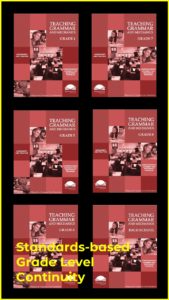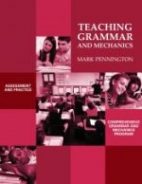Grammar and the Common Core
 I hear the same two comments at English-language arts conferences all the time: 1. “I’ve heard that research has proven grammar, usage, mechanics, spelling, and vocabulary instruction doesn’t work.” 2. “I teach grammar and they seem to get it. They pass my tests and do okay on the standardized tests, but they don’t transfer the learning to their writing or speaking. And they just don’t retain what we’ve covered. Their next-year teacher always asks why I don’t teach grammar, usage, mechanics, and spelling.”
I hear the same two comments at English-language arts conferences all the time: 1. “I’ve heard that research has proven grammar, usage, mechanics, spelling, and vocabulary instruction doesn’t work.” 2. “I teach grammar and they seem to get it. They pass my tests and do okay on the standardized tests, but they don’t transfer the learning to their writing or speaking. And they just don’t retain what we’ve covered. Their next-year teacher always asks why I don’t teach grammar, usage, mechanics, and spelling.”
So, should we bother teaching grammar, usage, mechanics, and spelling? Some would say “No.” This is what Dr. Stephen Krashen recommends, at least until high school. Dr. Krashen finds that students learn grammar, usage, mechanics, spelling, and vocabulary most efficiently through free voluntary reading, not explicit instruction or even writing, as my old National Writing Project colleagues would advocate. Now, to be fair, Dr. Krashen does see the value of teaching some usage issues and grammatical terminology. And he advocates teaching students how to use language resources, such as language handbooks, to correct errors and improve writing style. But he, and others of his ilk, certainly support the overall position described in the first comment listed above. My view is that the collective jury is still out on this research question.
Irrespective of the research into the effectiveness of explicit grammar, usage, mechanics, and spelling instruction, the writers of the new Common Core State Standards (CCSS) certainly affirm the need for instruction in these skill and content areas. In fact, grammar, usage, mechanics, spelling, and vocabulary now have their own CCSS Language Strand in the English Language Arts Standards. Apparently, language instruction is back in style.
According to the CCSS writers, “Students must have a strong command of the grammar and usage of spoken and written standard English to succeed academically and professionally.” And, despite the comments of the CCSS writers designed to placate English-language arts teachers clinging onto a teach-grammar-only-through-writing approach, the pendulum has definitely swung back toward explicit instruction of these Standards.
Even the most recent National Council of Teachers of English (NCTE) position statement in the NCTE Guideline now stresses the importance of direct instruction in these areas with the caveat that instruction must be connected to reading, writing, and speaking. Regarding instructional approaches, the NCTE position might surprise some die-hard anti-grammar fanatics:
Experiment with different approaches until you find the ones that work the best for you and your students. Some teachers focus on showing students how phrases add rich detail to sentences. Other teachers find that sentence diagrams help students see the organization of sentences. Some use grammar metaphors (the sentence, for example, as a bicycle, with the subject as the front wheel and the predicate as the back). Some emphasize the verb as the key part of speech, showing students how the sentence is built around it and how vivid verbs create vivid sentences.
But, back to the teacher comments at the English-language arts conferences. The second comment listed above reflects the common experience of so many English-language arts teachers in their own classrooms. There just is no doubt that students tend to have troubles transferring their learning of grammar, usage, mechanics, and spelling to writing and (with grammar and usage) speaking, not to mention next-year’s-teacher.
The CCSS writers acknowledge and validate this common experience. The CCSS writers explicitly recognize the cyclical nature of formal and standard language acquisition in their narrative and in the Standards themselves. To wit, the Standards include specific “Progressive Language Skills” to review, practice, and build on key Standards precisely because of the “recursive, ongoing nature of grammatical knowledge.”
However, simply acknowledging the fact that students have trouble with language transfer does not solve the problem. Teachers do need to take a fresh look at instructional approaches. One approach would be to take a hard look at how students have learned some grammar, usage, mechanics, and spelling and then devise instructional approaches to replicate this success for other un-mastered language content and skills. In other words, find out what has worked and do more of that.
What Works
1. We know from language acquisition research and classroom practice that new skills are best acquired when students notice and understand, before practice. That is, input is more important than output for student mastery of skills and/or content. This appears to be true for both primary language and secondary language students. Production, that is writing and speaking application and practice, should come after a certain degree of mastery has been acquired.
Application: Provide comprehensible input via oral language to learn grammar, usage, mechanics, spelling, and vocabulary content and skills. Teaching grammar, usage, mechanics, spelling, and vocabulary through active listening and interactive discussion with plenty of examples makes sense. Use mentor texts to analyze how writers and speakers use the language skill and content.
2. We have to teach through successive approximation and build upon prior knowledge.
New learning best takes place in context of the old. The CCSS “Progressive Language Skills” identifies the key Standards to scaffold instruction. Expect the need to re-teach foundational language skills and content.
Application: Begin the year with extensive review of language skills and content. Reference and practice prior Standards, then build upon these foundations to extend learning.
3. Students can chew gum and walk at the same time. Teach language form and meaning concurrently. Form influences meaning and meaning influences form. The CCSS Standards integrate form and meaning: traditional and descriptive approaches to language learning.
Application: Target the specific skill or content to be learned and teach, then practice in all of the communicative contexts. Teach the academic language, show and practice the variety of grammatical structures, validate the different purposes and forms of communication and contrast to Standard English, and provide a meaningful rationale for learning “correct” English to motivate learning.
4. Practice output in both contrived and meaningful contexts.
Application: Use canned, repetitive practice in limited doses. Most students don’t have to do “all of the even number exercises on page 223” to master a skill and/or concept. “Drill and kill” worksheets never killed anyone. But, contrived practice needs to target specific skills, inform the student as to “what is correct and what is not” via immediate feedback, provide a basis for formative assessment, and help the student practice skills and content already learned (#s 1 and 2 above.) Teachers do need to provide authentic writing tasks to practice what has been learned and give immediate and specific feedback regarding task application.
5. Assess learning, adjust instruction to re-teach, and differentiate instruction.
Application: English-language arts teachers need to buy-in to formative assessment to teach at the point of individual student needs. What good is it if we’ve “taught it,” if they haven’t learned it? That next-year’s teacher does have a point. And tracking students into remedial, regular, and honors classes does not address this point. Tracking, whether beneficial or not, is about delivery of content and skills, not about differentiating instruction according to what students have or have not learned.
6. Explicit instruction in syntax with a focus on function i.e., the job the part of speech, phrase, or clause does in the sentence.
Application: Don’t just wait until the editing stage of the writing process to work with students on syntax. Don’t rely on mini-conferences to do the hard work of syntactic instruction. Incidental, implicit instruction in syntax with no instructional scope and sequence won’t improve reading comprehension, nor increase writing sophistication.
*****

Pennington Publishing Grammar Programs
Teaching Grammar, Usage, and Mechanics (Grades 4, 5, 6, 7, 8, and High School) are full-year, traditional, grade-level grammar, usage, and mechanics programs with plenty of remedial practice to help students catch up while they keep up with grade-level standards. Twice-per-week, 30-minute, no prep lessons in print or interactive Google slides with a fun secret agent theme. Simple sentence diagrams, mentor texts, video lessons, sentence dictations. Plenty of practice in the writing context. Includes biweekly tests and a final exam.
Grammar, Usage, and Mechanics Interactive Notebook (Grades 4‒8) is a full-year, no prep interactive notebook without all the mess. Twice-per-week, 30-minute, no prep grammar, usage, and mechanics lessons, formatted in Cornell Notes with cartoon response, writing application, 3D graphic organizers (easy cut and paste foldables), and great resource links. No need to create a teacher INB for student make-up work—it’s done for you! Plus, get remedial worksheets, biweekly tests, and a final exam.
Syntax in Reading and Writing is a function-based, sentence-level syntax program, designed to build reading comprehension and increase writing sophistication. The 18 parts of speech, phrases, and clauses lessons are each leveled from basic (elementary) to advanced (middle and high school) and feature 5 lesson components (10–15 minutes each): 1. Learn It! 2. Identify It! 3. Explain It! (analysis of challenging sentences) 4. Revise It! (kernel sentences, sentence expansion, syntactic manipulation) 5. Create It! (Short writing application with the syntactic focus in different genre).
Get the Diagnostic Grammar, Usage, and Mechanics Assessments, Matrix, and Final Exam FREE Resource:
![]()
Get the Grammar and Mechanics Grades 4-8 Instructional Scope and Sequence FREE Resource:
![]()





